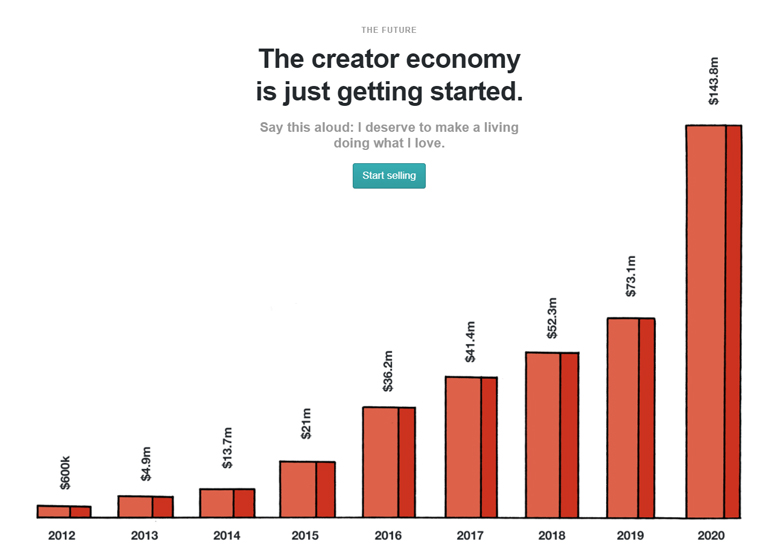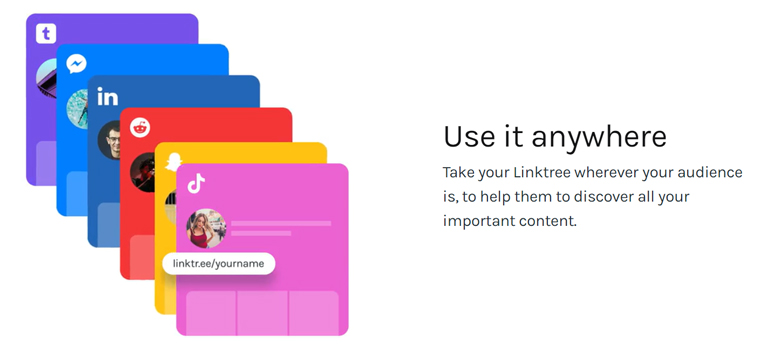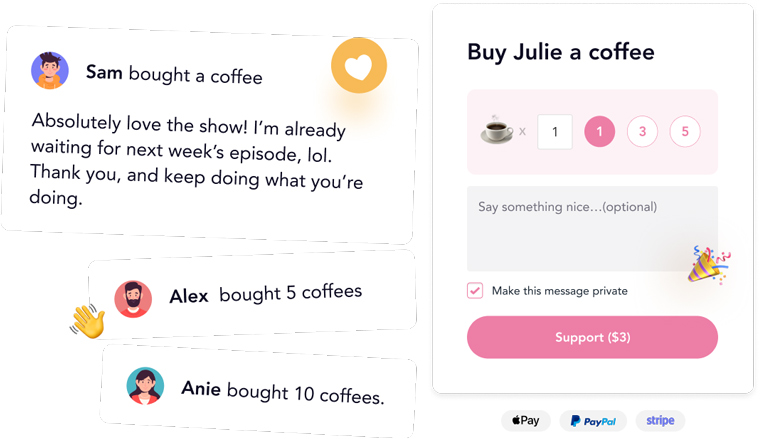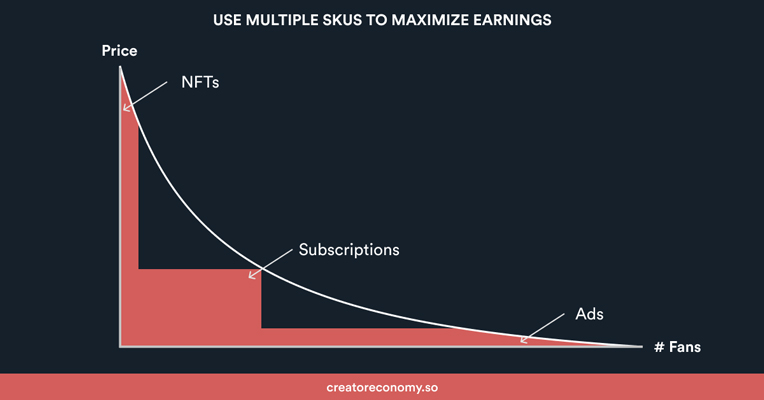A creator is a person that produces and monetizes their content through the direct support of his/her audience. Most often that support comes in the form of contributions, tip jars, or paid community subscriptions.
The term “creator” was coined by YouTube in 2011 and first emerged in The Youtube Creator Playbook (pdf). During the next 5 years, they promoted the term which then got accepted by Tumbler (Creatrs Network in 2015), WeWork (WeWork Creator Awards in 2017), and the Streamy Awards when they designated top YouTubers as Creator of the Year.
To better understand what is a creator we need to make a clear distinction between creators and influencers.
The difference between creators and influencers
While influencers depend on brand deals, creators monetize their content directly through their audience via donations, tip jars, or paid community subscriptions.
Influencers promote brands, products, services, affiliate links, or their merchandise. For them, content is a way to increase their followers and reach which in turn increases their price on the market.
Creators, on the other hand, focus only on the quality of content they produce. Through educational or entertaining content they hope to meet the interest and overcome the challenges of a specific audience.
Although most influencers are creators, a small percentage of creators consider themselves influencers.
Free Download: 15 creator economy pitch decks (247M raised)
There are a couple of stages that the creator space evolved through since 2011.
- Stage 1. Creators getting paid through ad revenue shares by YouTube and similar platforms for bringing in users to their platforms.
- Stage 2. Creators collaborate with brands to promote products and services to their fans.
- Stage 3. Creators diversify their revenue streams and are being funded directly by their fans via tipping or patronage.
Why all these changes in less than a decade?
With social media influencer/creator rising as a full-fledged career, indirect monetization proved insufficient.
Brand deals often come with strings attached and can fluctuate largely from month to month. Most importantly they force creators to cater to broad audiences making it impossible for them to focus only on a specific niche or demographics they like.
With the rise of the creator economy, influencers, but also regular people can redefine their worth.
Someone who needs a job can find themselves working for $10/hour if they have no other choice. Obviously, that’s not the actual worth of a person.
Usually, people have a hidden passion, talent, or hobby that they never thought they could monetize due to low demand for those skills.
But this new economy enables creators to put those skills to work and decide for themselves what they are actually worth.
What’s the Creator Economy
The creator economy is a new economic model in which creators can monetize their content from their fans. The creator economy is consisted of over 50M creators and 300 software and finance tools designed to help them grow and monetize.
The creator economy is estimated to be at $104.2 billion, with a noticeable growth rate when compared to that of the Gig Economy (trillion-dollar valuation in the future).

300 creator-focused companies enable creators to have direct access to their fans making them better protected from social media giants or their algorithm changes.
Creators combine multiple software tools to assemble a plethora of revenue streams in line with their style, no matter how niche.
That’s a win for creators as well as everyone else.
Because creators can finally build a real career while producing content tuned to every sub-culture in the rainbow.
4 Types of Creators
No matter the platforms, channels, or approaches to creation, we can group all creators into four broad categories:
- Social media creator
- Content Creator
- Video creator
- Audio creator
The groups are formed based on the type of content they produce. Let’s briefly cover each of these categories.
Social media creator
Given that there are half a million influencers on Instagram (with lots of followers) the number of creators with a significantly smaller audience than influencers is presumably in the tens of millions.
Creators on Instagram tend to share content related to fitness, health, beauty, and fashion because Instagram is a visual platform.
What type of content do social media creators produce? Everything from articles, guides, images, Stories, and live videos to contests, testimonials, announcements, and reviews.
*You’re currently reading an article by Influencers Club and we work with brands like Linktree, Beacons, Ribbon, Memmo, and Mighty Networks, and other big names in the space.
With an email database of millions creators, it’s super easy for us to find creators based on your targeted locations, gender and age, niche, and most importantly – specific keywords in their bio.
Take a sneak peek into our database and if you like the results and would like to learn how you can increase your user base with our data, book a call with our team on this link.
Content creator
Content creators are individuals who produce written content such as articles, sales copy, landing pages, and more. They often work across various types of content or are specialists who opt to write only a specific type of content.
Oftentimes, creators repurpose written content into other formats such as video to get more leads and exposure.
Here are the most common types of content these creators work on: articles, white papers, checklists, ebooks, and case studies.
Video creator
Video creators, also known as Youtube creators, vary widely in the way they approach content creation, the topics they cover, and how they integrate into the YT community. They use an effective YouTube Video editor to add more value to their videos before uploading them to this platform.
Let’s check out the different metrics you need to consider if you want to become a video creator or want to hire a creator for your brand.
- Channel Focus
- Size
- Production
- Partnerships
Youtube has 2.3 billion monthly active users and 50 million video creators compete for their attention. But, given that YouTube has paid out more than $30 billion to creators in the last three years they know the value of keeping the creators on the platform is far greater. After all, 75% of Millennials prefer watching YouTube to watching TV.
Audio creator
According to new research, currently, there are over 2 million different podcasts and 48 million episodes. But, if you’re planning on becoming a podcaster yourself there’s no need for discouragement. eMarketer estimates that the number of US podcast listeners will increase 16.0% year-over-year (YoY) to 106.7 million.
Top Creator Tools & Platforms
Over 300 creator-focused companies are capitalizing on every step of the creator work cycle. Be it content creation, off-platform monetization, audience management, and communication.
It’s common for a creator to use many tools for creating, editing, and earning money off their content which they then distribute to their fans. For example, a creator might finance a show with Karat, record in Snapchat, edit with Pixlr or inVideo, then post to Instagram. To monetize on-platform they might use Grin or Captiv8, earn money off-platform with Cameo or Teespring, and track their analytics with Delmondo.
So what are the best tools that creators use to monetize their content?
1. Patreon
Patreon is a membership platform that provides tools for creators to run a subscription service and get paid.
On Patreon, creators can let their fans become active participants in the work they love by offering them a monthly membership. Creators give them access to exclusive content, community, and insight into their creative process.
Patreon is used by 200 000 podcasters, video creators, musicians, visual artists, writers, gamers, etc.
The platform hosts more than 6 million monthly active supporters, known as patrons. These supporters contribute financially to creators, gaining membership benefits in exchange.
Among the most popular Patreon creators are Chapo Trap House with 38k patrons ($170k monthly earnings), DarkCookie with 25k patrons ($70k monthly earnings), and Flagrant 2 with 19k patrons ($91k monthly earnings).
2. Gumroad
Gumroad is a platform that facilitates the sale of products by creators directly to consumers.
Writers, designers, comic artists, developers, educators, musicians, and anyone in-between use Gumroad to sell stuff they make.
With Gumroad creators sell to their audience by:
- Building their own email newsletter
- Integrate Gumroad onto their website
- Sell on Twitter, Facebook, YouTube, Instagram, and more
- Use affiliates to help creators sell
3. Linktree
What’s Linktree? Simply put, Linktree is a tool that allows creators to host multiple links in their Instagram biography. Instead of updating your bio link every time you publish a new blog post or start a promotion, you can update your Linktree landing page in just a few clicks.

The platform averages 30,000 daily sign-ups, a user base of 14M+, and has over half a billion visits to Linktrees each month. In the past 12 months, Linktree has gained phenomenal momentum growing its user base by 3x with no signs of slowing down.
It’s free, unless you opt for PRO features, with click-through rate stats and the Amazon integration means you could potentially earn more money from affiliate links.
If you want an alternative to Linktree, Beacons.ai is also a link aggregator – a direct competitor to Linktree and offers more premium features for free.
4. Cameo
Cameo is an online marketplace where people can order personalized shout-outs from creators and celebrities. It’s accessible as a website and (for US residents only) an app, selling performances from across the entertainment sectors.
If you have more than 20,000 Instagram followers, you can request to join Cameo yourself. Today, the company says, one in five of their personalities signs up for the platform this way.
Actors, musicians, comedians, athletes, reality stars and more can be found in its directory.
Personalized clips lasting only a few minutes are produced by over 30,000 creators ranging from A- to D-list stars who charge anywhere from $5 to over a grand per video
5. Buy Me a Coffee
Buy me a coffee is a platform for online social media creators to receive tips and donations to support their work. While the title is “Buy me a coffee,” subscribers are donating money to you as a one-time donation or as a recurring, scheduled donation.
The platform has 300,000+ creators and is mostly used by video creators, writers, musicians, podcasters, artists, and developers.
Buy Me a Coffee has a similar model to Patreon but the main difference is that you can be paid by anyone (no need to be members or subscribers) to show gratitude for your work.
BMC has a 5% fee per transaction meaning the platform only makes money when you do.

How Do Creators Make Money?
There are few ways how creators make money online. Most commonly they use patronage platforms (tip jars, subscription, and project-based funding), selling fan engagement, courses, community subscriptions, merchandise, and sponsorships.
Patronage Platforms
Let’s cover the different types of donation-based funding along with the most popular platforms.
Ad hoc project-based funding
When creators publish their one-off albums, short films, books, comics documentaries, etc they do ad hoc project-based funding. The biggest crowdfunding platforms are GoFundMe, Indiegogo, and Kickstarter, and their usual fee rate is 5%.
Subscription-based funding
Remember the Pomplamoose band? The leading guitarist was none other than Jack Conte (the co-founder and CEO of Patreon) and he wanted to find a way for consistent financial support for his band and their production studio. That’s how Jack came up with the concept of “subscribing $10/month to your favorite creator”.
More recently, Twitch and Youtube gave creators the option to charge a subscription fee for channel membership.
Twitch Subscriptions provide a recurring income to streamers. You can encourage your followers to subscribe to your channel for either $4.99, $9.99, or $24.99 per month. The money collected is split 50/50 between Twitch and the streamer (although a few top streamers have been able to negotiate a higher percentage). Subscribers get benefits like ad-free viewing on your channel and chats during streams.
Youtube Channel memberships allow fans to join a channel through monthly payments and get members-only perks like badges, emoji, and other goods. All YouTube Memberships cost $4.99.
To check your eligibility for the program (a minimum of 1k channel subscribers, etc) visit this page.
Tip jar concept
Recurring and predictable income has tons of benefits for creators but a few downsides too.
There’s small but significant friction for fans to get involved and also by requiring upfront payment creators don’t reach all of their audience. With tip jars, fans voluntarily support the creator financially with one-time donations. Platforms like Ko-fi and Buy Me a Coffee give creators the option to ask their audience for $5 here and there.
For years, Twitch streamers have set up donation links on their profiles through third-party tools or solicited tips directly through Twitch’s currency system, Bits. Major platforms, like Facebook, YouTube, Instagram, Twitter, and TikTok, have since developed their own tipping systems for shoutouts during live streams.
Selling Fan Engagement
Fans love to interact with their favorite creators. Cameo dominates this space as an online marketplace where fans pay creators, influencers, and celebrities for short custom-made video shoutouts.
While Cameo is limited to videos only, Starsona allows creators to sell all kinds of fan interactions such as 1:1 direct messaging, Q&A, critique a photograph, sing a duet, etc.
Camelot goes a step further and allows fans of Youtube and Twitch creators to get creative and pay for what they want to see. For example, they can request from streamers to “play without armor”, “play a cover of Hey Jude” or “add a heartbeat monitor to the stream”.
Selling Online Courses
Anyone with a valuable skill to share, be it abstract painting, healthy cooking, or singing opera, can use online course builders like Kajabi, Teachable, Thinkific, Podia, or Gumroad. These platforms offer a full suite of products that enable creators to market, engage and monetize their courses.
Course creators also leverage popular social media platforms to build an audience, share bits of their course content and then redirect the most engaged learners to their course page.
Selling Newsletters
Authors, journalists, and other writers use platforms like Substack to build their own audiences, set a subscription fee, and monetize their newsletters.
A steady fan base of 1k subscribers on Substack paying $5 each month will earn $60,000 per year, before fees and taxes, of course.
Writers can choose whether to make a newsletter subscription free or paid and to make specific posts publicly available to non-subscribers. The minimum subscription fee on Substack is $5/month or $30/year. Substack usually charges a 10% fee from subscription payments.
Selling Merchandise
Creators that sell their own apparel (or pens, mugs, caps, mouse-mats, T-shirts) use platforms like Fanjoy and Teespring, both of which can integrate with Youtube, Instagram, and Twitch.
Generally, only the biggest fans will purchase merch from a creator, and then there’s the cost of production and product distribution. These are the main reasons why selling merch is often a side gig and not the main source of revenue for creators (more on this later), although there are many successful exceptions.
One example is Paul Logan, a controversial yet successful creator known for creating a variety of content including sketches, music, and even challenging professional boxers to fights.
Not only does Logan create merchandise but he has even created his own line of clothing called Maverick.
Advertising
While many of us find YouTube ads super-annoying we should remember that if it was not for those advertisements there might be no content in the first place.
The YouTube Partner program for video creators accepts individuals with more than 1k subscribers and 4,000 hours of viewed content in the last 12 months. If you’re part of the program you can earn money through YouTube ads shown on your videos.
According to InfluencerMarketingHub, for every 1k views, a creator receives approximately $18.
NFTs
NFTs, which stand for non-fungible tokens are unique digital assets (such as a digital piece of land in a video game) with blockchain-managed ownership.
It’s easier to understand the concept with an example:
Let’s take Adele for example.
- She uploads a new song to Spotify and it gets 1M plays. Unfortunately, Spotify only pays ~$4,000 for 1M plays. After their record label, management, etc. take their cut, she is left with just $800.
- Record labels own Adele’s content rights and she can’t even perform the song without their permission.
- And finally, Spotify can change its algorithms or even remove Adele from its platform ( in 2015 Adele’s album “21” didn’t make it on Spotify).
If Adele creates an NFT for her song that says:
Adele is the original creator of this song. She’s selling its ownership for $60,000. Every time someone resells this song, Adele gets 10% of the sale price.
When a fan buys her NFT for $60k and the marketplace takes 15% she earns $51,000.
And, just like with stocks, if the popularity of Adele rises in the next year the fan can resell to another fan for $100,000. Adele makes 10% off that purchase in royalties.
Even though NFT’s exist less than a year, the current growth and potential are enormous.
The bottom line of NFT’s in the creator economy is that most of the value should go to the creator and the fans, not the platforms that stream third-party content.
How to Maximize Earnings as a Creator
Peter Yang in one of his latest articles talks about how to maximize your earnings based on fan willingness to pay using the Creator Demand Curve.
According to Peter, all fans can be separated into three groups based on their willingness to support a creator:
- Casual fans aren’t willing to pay anything – Ads.
- Active fans are willing to pay a small amount – Subscriptions.
- Superfans are willing to pay a lot – NFTs.
To maximize their earnings, creators need to have multiple income streams (Ads, Subscriptions, Tips, NFTs) targeted at different fan willingness to pay.

Additionally, platforms should offer multiple monetization products to help creators maximize their earnings. Twitch realized the same and offers:
- Ads for a creator’s casual fans
- Subscriptions for a creator’s active fans
- Gifted subscriptions for a creator’s superfans
FAQ
According to the “100 True Fan model”, a creator can be successful with 100 followers that truly benefit from the content the creator produces. While making a living off the 100 True Fan model is far from commonplace, it’s increasingly possible.
The best creators on Instagram are:
- Zach King @zachking
- Mike Mattera @witness
- DON🧠@vxfashion
- Vivi Castrillon @vvcastrillon.fit
- Vladtv @vladtv
- Christina Scherer @travelinghoppy
- Donnell Blaylock Jr. @therealdonnysavage
Findcreators.io is a tool that lets you search and find the creators you need for free.
Creator marketing involves brands collaborating with creators to promote products or services. Brand deals can be only one of the ways creators monetize from their followers.
An average creator with 2,000 YouTube subscribers earns $200 per month.
According to SignalFire, there are 50 active million creators. However, as the barrier of entry in the creator market decreases, we’ll see more people becoming creators.
- Identify your biggest skill or talent
- Decide on the content format (video, podcast, images)
- Produce exceptional content for your niche
- Gain an audience on social media
- Redirect your fans to a monetization platform
FIND THE PERFECT CREATORS
Scale your outreach and pick the perfect creators for your brand from our influencer database searchable by 30+ smart filters


